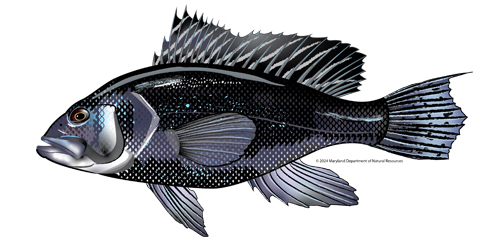| Black Sea Bass |
 |
Black Sea Bass |
| Centropristis striata |
(A.K.A. - Black will, Sea bass)
|
Key Distinguishing Markings:
- Black sea bass are members of the Family Serranidae or true sea basses and groupers.
- They are typically large-mouthed, bottom dwellers that are bluish black in color with light spots that form longitudinal stripes.
- Their scales are relatively large and their dorsal fin is continuous, but notched with 10 slender spines.
View the Black Sea Bass Gallery
|
Distribution:
- They range from Maine to the Florida Keys and into the Gulf of Mexico.
- Along the Atlantic coast, black sea bass are divided into two stocks for management purposes.
- The northern stock resides north of Cape Hatteras and is seasonally migratory.
- The southern stock resides south of the Cape and is not migratory.
|
Size:
- Black sea bass are reported to grow to a maximum of 24-25 inches in length and live 15-20 years.
|
Habitat:
- Adult black sea bass are considered to be a temperate reef fish.
- They are typically bottom dwelling marine fishes and are most often found on rocky bottoms near reefs, wrecks, oyster bars, pilings, or jetties.
- They are predators, relying on their large mouths and swift movements to capture their prey.
- Adults migrate inshore and northward as water temperatures increase in the spring.
- They return to coastal and ocean waters, moving southward and offshore in the fall as water temperatures drop.
- As juveniles, they typically move inshore to the lower Chesapeake Bay during April and remain until December.
- They have been captured as far north as the mouth of the Chester River. However, juvenile fish prefer saline waters and are most prevalent in salinities above 18ppt.
- Black sea bass are bottom dwellers and find shelter in areas with structure. Here, they feed primarily on crustaceans such as shrimp, amphipods, and isopods.
|
Spawning:
- Spawning in the mid-Atlantic region takes place in deeper waters off the continental shelf from June through October with a peak in July and August off the coast of Virginia.
- Female black sea bass usually mature by ages 2-5 and produce approximately 280,000 pelagic eggs which are buoyant and contain a single oil globule.
- Larval development occurs in coastal waters.
|
Fishing Tips:
- Black sea bass are regarded as a good-eating, flavorful fish.
- Bottom fishing from boats near structure (rocks, wrecks, and reefs) using squid and other natural baits works best to catch these fish.
- For current recreational size and creel limits, see Maryland's updated regulation page.
|
Fun Fact:
- Black sea bass are protogynous hermaphrodites, functioning first as females and then as males.
- Sex reversal may not occur in all fish; only 38% of the females in the mid-Atlantic were observed to be hermaphroditic.
- Sex reversal generally occurs between the sizes, 9½-13 inches: most fish 8 inches and below are female.
- Sex reversal is probably a post-spawning event since it occurs most frequently from August through April.
- Social interaction may play a role in sexual transformation; the removal of large male fish from a local population may induce one or more of the largest remaining females to change sex and assume the male role.
- The recreational fishery for black sea bass is important along the Atlantic coast of Maryland. Approximately 35% of the Mid-Atlantic coast (Maryland & Virginia) recreational black sea bass landings are harvested from state waters, which includes bay waters out to 3 miles.
|
| Family: Serranidae (Sea basses: groupers and fairy basslets) |
| Order: Perciformes (perch-likes) |
| Class: Actinopterygii (ray-finned fishes) |
For more information on black sea bass and their management, please contact Steve Doctor or Nancy Butowski.
Illustration by Kevin Ensor,
Maryland Department of Natural Resources,
Fishing and Boating Services
|
